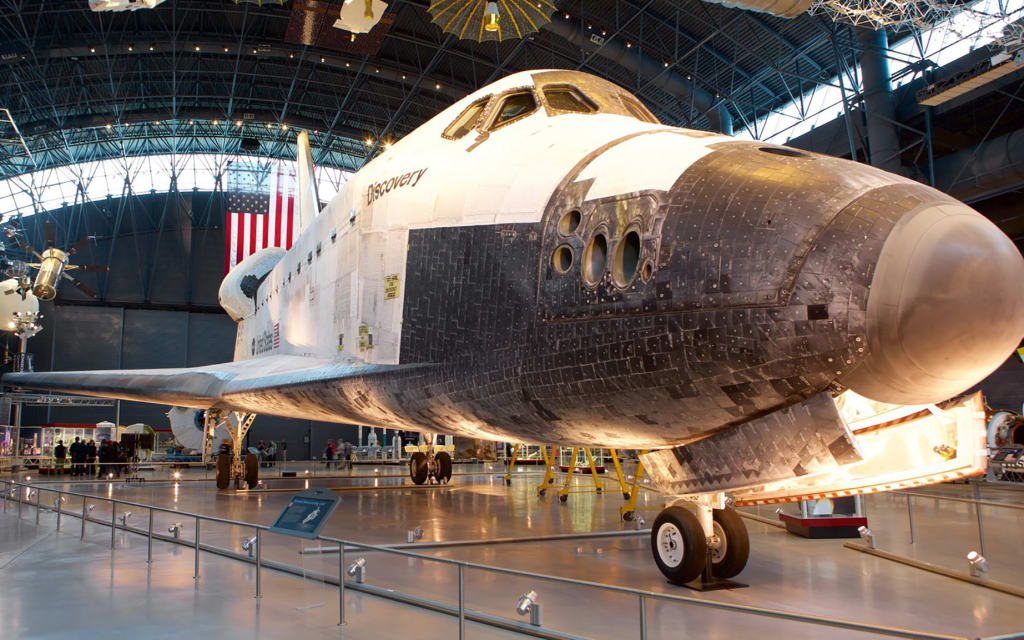Aviation Museum Guide
The best space and aviation museums span the country and offer a sky of knowledge.

In the short span of aviation history, a legacy of machines and accomplishments has developed. Much of this information exists in the museums of America. Some museums attempt to portray the whole history of aviation; others convey only various aspects of it. For anyone with even the mildest curiosity regarding rockets, airplanes, and flying, aviation museums hold a ticket that will satisfy even the greatest of air travel enthusiasts.

Photo via Air and Space Museum
National Air and Space Museum
The most spectacular exhibition must be in Washington, DC at the Smithsonian's National Air and Space Museum, which is visited by nearly 10 million people per year. This massive monument to flight is dominated by three giant glass-roofed galleries. There are also 20 smaller displays for exploration. The 1903 Wright Kitty Hawk Flyer holds the premier spot in the first gallery. This gallery also contains some of the most significant specimens in the history of flight, including Lindbergh's Spirit of St. Louis, the X-15 supersonic rocket plane, and the Gossamer Condor.
The second gallery houses a selection of the largest real airliners the Smithsonian could accommodate—including a DC-3 hanging from the ceiling! This area of the museum also includes exhibits showing the story of air transportation. The third gallery, Space Hall, is among the most awe-inspiring displays of human accomplishment anywhere on Earth. Huge rocket boosters frame the hall, which contains such space finery as the Skylab orbital workshop and the linked Apollo–Soyuz spacecraft. The hall's centerpiece boasts the original Lunar Lander backup craft, a duplicate of Eagle, which brought men to the Moon in 1969. Some of these are arranged so the public can walk through them.
Each of the 20 smaller galleries is dedicated to a separate subject or theme, such as World War I aircraft, air racers, military jet fighters, helicopters, and so on. When taken in totality, they cover the entire subject of flight.
Visit the National Air and Space Museum.
United States Air Force Museum
The next most popular aviation museum is at the Wright Patterson Air Force Base near Dayton, Ohio. Unless you see it, it's difficult to imagine a B-36, a Mustang, a B-17, a B-25, a Twin Mustang, a dozen jets, and more contained in one room. Almost any aircraft the Air Force has used is included and displayed in two huge hangars. And because wingspans vary from 7.5 to 69 meters (25 to 230 feet), it is possible to arrange an incredible number of planes together. Although ropes and barriers are used, and in some cases the planes are too close to walk around, the displays allow an excellent opportunity to admire a wide variety of airplanes close up.
Across the field is an annex filled with parts, aircraft, and artifacts awaiting their turn to shine again. The restoration shops are busy with an estimated 12 to 20 years' work for the museum waiting in the annex. More buildings are planned for the overflow and the newly restored machines as they roll out of the shops. The Air Force Museum collection is stunning—a must for aviation buffs.
Visit the United States Air Force Museum.
The Franklin Institute
The Hall Of Aviation at The Franklin Institute in Philadelphia is filled with airplanes you can see, touch, and climb into. The Institute includes “Hands-on" exhibits and actual planes to chronicle the whole history of air travel. The first display visitors encounter in the Hall is a Wright biplane suspended from a six-meter-high (20-foot) ceiling. It's an impressive item from The Franklin Institute's extensive collection of Wright brothers artifacts—the largest holding of its kind in the world. The Institute plans to showcase the Wrights' original drawings, notes, airfoils, and lift balance materials this December in a special celebration of the 75th anniversary of powered flight.
Beneath the Wright biplane is an assortment of modern aircraft: a Beechcraft Sierra, a Beechcraft Bonanza, and a Boeing-Blokow helicopter. A T-33 military jet trainer perched high above the floor is an irresistible draw for children, who love to sit in its cockpit and handle the controls. There is also a mechanical flight simulator for all would-be pilots. Dwarfing its smaller relatives is a retired British Airways 707 parked just outside.
Experimental Aircraft Association Museum
Widely varying in content, this aviation museum in Hales Corners, Wisconsin (near Milwaukee) features anything and everything pertaining to aviation, from an original 1911 vintage Curtiss in flying condition to modern-day jets. The concept of EAA is member involvement with aviation of any kind; be it examining armchairs and photography, collecting name plates, old movies, flying, designing, restoring, acrobatics, record breaking, model making, replica building, etc. In August of each year, there's a mad rush to hold the world's largest air operation and convention.
This amazing museum makes the visitor aware that he too can have a part in aviation; infinite money and training are not necessary. Many of the aircraft at the EAA Museum are originals: the Curtiss Sweetheart of 1911, a JN-4 Jenny, a Junkers Stuka, HM Flying Flea, a Fort Trimotor, a Heath Parasol, and more. Over 90 airplanes of the collection of 190 are on display. Some are restored, some are in serviceable condition, and others are partially rebuilt. A book and souvenir area carries manuals and plans for building aircraft—many published by the EAA. The staff, which is knowledgeable and courteous, readily answers visitors' questions. This museum, better than any other, says that flying is fun and something in which you are capable of taking part.
Visit the Experimental Aircraft Association Museum.

Photo via Pinterest user Michael Kearney
The Wright Brothers National Memorial
This memorial to commemorate the long-lasting impact of the Wright brothers is located in Kill Devil Hills, North Carolina, the site of the first successful powered airplane flight. Reconstructions of the shop and hangar stand as they did 76 years ago, complete with stove, beds, and other mementos. Towering over all this is the dune called "Kill Devil Hill," with the Wright monument thrusting skyward from its crest. The visitor center contains tools and equipment used by the Wrights as well as drawings, several engines from the first aircraft experiments, and reproductions of the 1902 Wright Glider and the 1903 Wright Flyer. The items exhibited at Kitty Hawk are duplicated elsewhere, but for a sense of history and the beginnings of aviation, a visit to the Wright Brothers National Memorial is unbeatable.
Visit The Wright Brothers National Memorial.
Paul E. Garber Facility
In Suitland, Maryland, the museum known as “Silver Hill” serves as the revamped storage and restoration facility for the National Air and Space Museum. It contains large aircraft, such as Enola Gay, the B-29 that dropped the atomic bomb, and some marvelous civil aircraft. One attraction, for example, is the Canard photo plane made by an aerial photo company for its own use. There are over 100 aircraft on display, and the restoration shops are now open to the public. It is a wondrous place for the airplane buff to visit.
Visit the Paul E. Garber Facility.
Glen H. Curtiss Museum of Local History
Some of the smaller museums are filled with surprises. This museum located in an old school building in Hammondsport, New York, is stuffed from cellar to top floor with local historical objects, dolls, kitchen utensils, costumes, uniforms, and glass slides and photographs of early aviation in Hammondsport. Many of the exhibits relate to Glen H. Curtiss, his airplanes, bikes, motors, awards, newspaper clippings, and photographs. Among the ten aircraft displayed are reproductions of the June Bug of 1908 and the Mercury Aircraft Company Chick of 1929.
Visit the Glen H. Curtiss Museum of Local History.

Photo via Good News Travels
The Alabama Space and Rocket Center
For liquid propulsion fanatics, the Alabama Space and Rocket Center is considered the world's largest exhibit on space exploration and rocketry in Huntsville, Alabama. The center also serves as the Visitor Information Center for NASA's Marshall Space Flight Center. Within the main building are many models and displays of rockets and spaceflight. Recent "sens-u-round" type additions are the Lunar Odyssey space travel experience and the Zero-Gee Machine, where one can feel the weightlessness of outer space.
Outside, the building visitors can walk through a forest of projectiles varying in size, shape, and function from anti-tank missiles to the giant Saturn V moon rocket.
A two-hour bus tour of the Marshall Space Flight Center departs from this building several times a day. Travelers may step off the bus and into a Skylab, mockup, or the Neutral Buoyancy Simulator where astronauts train for space missions.
The Center, located on Highway 20 in Huntsville, is open daily year-round (except on Christmas Day).
Visit the Alabama Space and Rocket Center.
Frederick C. Crawford Auto/Aviation Museum
In Cleveland, Ohio, squeezed among 150 antique automobiles are several Thompson Air Race Trophy winners. Frederick C. Crawford headed Thompson Products and donated the Thompson trophy. There are only a few other airplanes in the exhibit, but the ones there are rare and beautifully restored. A Curtiss Oriole (1920), which is one of the first to use a molded plywood fuselage, sits in the museum. Two Curtiss Flying Boats are especially noteworthy.
Visit the Frederick C. Crawford Auto/Aviation Museum.
Old Rhinebeck Aerodrome
Just north of Rhinebeck, New York, this museum recaptures the thrill and excitement of early aviation. Airplanes of the Pioneer and Lindbergh eras are used in the air shows on Saturdays, and World War I aircraft are used in the mock battles of the Sunday afternoon shows. These weekend shows are wonderful fun for the whole family, as well as for the serious aviation enthusiast, who will see such airplanes as a Sopwith Pup, SPAD XIII, and a Fokker D.VII actually flying. There are over 40 aircraft in the collection; more than half fly and are used in the shows.
Naval Aviation Museum
Located in Pensacola, Florida, this naval museum does not have as extensive a collection as that of the Air Force, but the aircraft are beautifully restored and handsomely displayed. They range from a faithful reproduction of the A-1 Amphibian, the Navy's first aircraft (1911), to modern-day jets of types still in active service. The building, which is expandable by design to include more exhibits when funds become available, houses the giant NC-4 Flying Boat (the first aircraft to fly across the Atlantic) in one corner, a PBY Catalina in another, and groupings of some of the most beautiful airplanes ever, Do take a camera; excellent color photographs may be obtained without flash or tripod during normal public hours. Another delight of this museum are the personnel, who were vitally interested participants in Naval aviation in the past. Like aviators the world over, they enjoy talking about flying and airplanes more than anything else.
Visit the Naval Aviation Museum.
Taking Flight
Air travel bewildered our ancestors for centuries before the first humans successfully took flight. Generations later, we are blessed to travel in luxury with cheap flights around the world. However, we must not forget the dreamers who brought us to where we are today. Everyone has heard of the Wright Brothers and their famous first flight. Even so, many aviation revolutionists are forgotten. Luckily, our country has a multitude of museums nationwide that honor these founding fathers who took the very first steps to achieving public air travel. Flights might seem like an invention of the past as we rarely consider the immense technology put into airplanes, but we must continue to praise the early achievements of aviators before they become ancient history.
About the Creator
Futurism Staff
A team of space cadets making the most out of their time trapped on Earth. Help.
Enjoyed the story? Support the Creator.
Subscribe for free to receive all their stories in your feed. You could also pledge your support or give them a one-off tip, letting them know you appreciate their work.






Comments
There are no comments for this story
Be the first to respond and start the conversation.